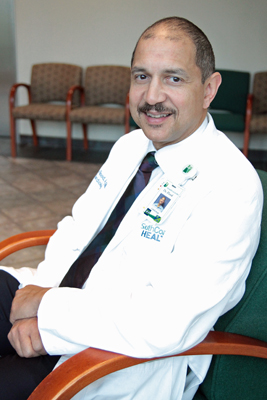All In The Wrist
A new approach to treating clogged arteries can make recovery quicker and easier
Have you ever taken your own pulse, or had a nurse take your pulse with just the tips of their fingers on your wrist? Your heart rate can be felt through your radial artery, which supplies your hand with blood. That same artery is now allowing cardiologists to perform a life-changing procedure for patients with narrowed heart arteries.
And there are quite a few of those patients out there—coronary artery disease (CAD) is the most common type of heart disease in the United States. Cholesterol and other deposits create plaque on the walls of arteries. The buildup of plaque in arteries that supply blood to the heart can partially, and sometimes totally, block the blood flow. A common symptom of CAD is angina, or chest pain. It is often an early sign of a heart attack.

Reshaping Blood Vessels
To treat blocked arteries, interventional cardiologists like Roy D. Flood, Jr., MD, of SouthCoast Health, perform an angioplasty (“angio-“ means relating to blood vessels, “-plasty” means reshaping or reforming a certain part). In this procedure, Dr. Flood guides a balloon catheter to the narrowed or blocked area and then inflates the balloon, reshaping and expanding the artery walls and improving blood flow. In many cases, a tube called a stent is placed in the re-opened area to ensure that it remains open.
“Patients often feel better quickly, with their energy returning and their symptoms of angina and shortness of breath improving,” Dr. Flood says.
When it was first developed in the late 1970s, angioplasty significantly changed the treatment of clogged arteries, helping many patients avoid the risks and extensive recovery period of open-heart surgery. Now, a new approach to the procedure is benefitting patients even more.
The Radial Artery
Access to the heart’s arteries has traditionally begun in the femoral artery, a major blood vessel in a person’s groin area. Though the angioplasty would help the patient’s blockages, they would now possibly face bleeding, swelling, or pain at the puncture site. In fact, patients would have to lie still for hours to prevent bleeding from the femoral artery. Dr. Flood avoids these complications by accessing the blood vessels through the radial artery in the patient’s wrist.
“When I perform an angioplasty this way, it provides several benefits to my patients,” Dr. Flood says. “They have increased mobility, meaning less down time for the patient, and in many cases there is less bleeding from the site.”
The smaller size of the radial artery makes it easier to stop the bleeding at the puncture site. And with only the patient’s wrist affected by catheter, patients are up and walking around much sooner.
“Recovery is not only quicker, it’s easier,” Dr. Flood says. “You still have to monitor the insertion site, but the patient is not stuck with immobility.”
Dr. Flood notes that a common anxiety about recovery is being unable to exert your heart enough to walk long distances or climb stairs, but the radial artery approach can at least help with practical issues that may arise.
“We’re more concerned about you bending that leg if you need to take a step up to get in your house,” he says.
Speaking of that return home, Dr. Flood says that patients treated with angioplasty through the radial artery can usually go home on the same day as the procedure.
Not every patient is a candidate for this approach. If someone has calcified arteries, for example, the smaller radial artery could be too difficult to navigate. But Dr. Flood is excited to be able to offer this approach to appropriate patients. During the procedure, patients are sedated but conscious, and the threading of the catheter is painless.
Getting Moving, Staying Healthy
“After their procedure is done, patients often tell me it wasn’t as ominous as they thought it would be,” Dr. Flood says. “Especially now with the radial approach, the procedure is less intimidating to the patient.”
Dr. Flood hopes that the improved energy and relief from symptoms that patients will experience after the procedure will help them take better care of themselves and prevent future cardiovascular disease. A patient’s ability to get up and move sooner after a radial artery angioplasty should be the first positive step toward a change in lifestyle.
“In the ideal world, everyone would stop smoking, eat a plant-based diet, take their medications, and manage their diabetes,” Flood says. He adds with a smile, “And I would be out of a job.”